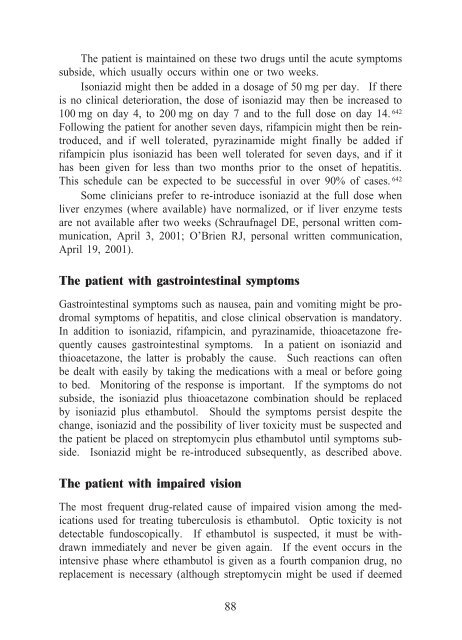Interventions for Tuberculosis Control and Elimination 2002
Interventions for Tuberculosis Control and Elimination 2002
Interventions for Tuberculosis Control and Elimination 2002
You also want an ePaper? Increase the reach of your titles
YUMPU automatically turns print PDFs into web optimized ePapers that Google loves.
The patient is maintained on these two drugs until the acute symptoms<br />
subside, which usually occurs within one or two weeks.<br />
Isoniazid might then be added in a dosage of 50 mg per day. If there<br />
is no clinical deterioration, the dose of isoniazid may then be increased to<br />
100 mg on day 4, to 200 mg on day 7 <strong>and</strong> to the full dose on day 14. 642<br />
Following the patient <strong>for</strong> another seven days, rifampicin might then be reintroduced,<br />
<strong>and</strong> if well tolerated, pyrazinamide might finally be added if<br />
rifampicin plus isoniazid has been well tolerated <strong>for</strong> seven days, <strong>and</strong> if it<br />
has been given <strong>for</strong> less than two months prior to the onset of hepatitis.<br />
This schedule can be expected to be successful in over 90% of cases. 642<br />
Some clinicians prefer to re-introduce isoniazid at the full dose when<br />
liver enzymes (where available) have normalized, or if liver enzyme tests<br />
are not available after two weeks (Schraufnagel DE, personal written communication,<br />
April 3, 2001; O’Brien RJ, personal written communication,<br />
April 19, 2001).<br />
The patient with gastrointestinal symptoms<br />
Gastrointestinal symptoms such as nausea, pain <strong>and</strong> vomiting might be prodromal<br />
symptoms of hepatitis, <strong>and</strong> close clinical observation is m<strong>and</strong>atory.<br />
In addition to isoniazid, rifampicin, <strong>and</strong> pyrazinamide, thioacetazone frequently<br />
causes gastrointestinal symptoms. In a patient on isoniazid <strong>and</strong><br />
thioacetazone, the latter is probably the cause. Such reactions can often<br />
be dealt with easily by taking the medications with a meal or be<strong>for</strong>e going<br />
to bed. Monitoring of the response is important. If the symptoms do not<br />
subside, the isoniazid plus thioacetazone combination should be replaced<br />
by isoniazid plus ethambutol. Should the symptoms persist despite the<br />
change, isoniazid <strong>and</strong> the possibility of liver toxicity must be suspected <strong>and</strong><br />
the patient be placed on streptomycin plus ethambutol until symptoms subside.<br />
Isoniazid might be re-introduced subsequently, as described above.<br />
The patient with impaired vision<br />
The most frequent drug-related cause of impaired vision among the medications<br />
used <strong>for</strong> treating tuberculosis is ethambutol. Optic toxicity is not<br />
detectable fundoscopically. If ethambutol is suspected, it must be withdrawn<br />
immediately <strong>and</strong> never be given again. If the event occurs in the<br />
intensive phase where ethambutol is given as a fourth companion drug, no<br />
replacement is necessary (although streptomycin might be used if deemed<br />
88

















